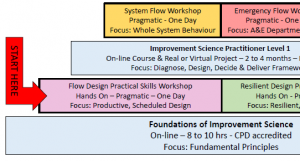 Have you heard the phrase “you either love it or you hate it“? It is called the Marmite Effect.
Have you heard the phrase “you either love it or you hate it“? It is called the Marmite Effect.
Improvement science has Marmite-like effect on some people, or more specifically, the theory part does.
Both evidence and experience show that most people prefer to learn-by-doing first; and then consolidate their learning with the minimum, necessary amount of supporting theory.
But that is not how we usually share what we know with others. We usually attempt to teach the theory first, perhaps in the belief that it will speed up the process of learning.
Sadly, it usually has the opposite effect. Too much theory too soon often creates a barrier to engagement. It actually slows learning down! Which was not the impact we were intending.
The implications of this is that teachers of the science of improvement need to provide a range of different ways to engage with the subject. Complementary ways. And leave the choice of which suits whom … to the learner.
And the way to tell if it is working is … the sound of laughter.
Why is that?
Laughing is a complex behaviour that leaves us feeling happier. Which is good.
Comedians make a living from being able to trigger this behaviour in their audiences, and we will gladly part with hard cash when we know something will make us feel better.
And laughing is one of the healthiest ways to feel better!
So why do we laugh when we are learning?
It is believed that one trigger for the laughter reaction is the sudden shift from one perspective to another. More specifically, a mental shift that relieves a growing emotional tension. The punch line of a really good joke for example.
And later-in-life learning is often more a process of unlearning.
When we challenge a learned assumption with evidence and if we disprove it … we are unlearning. And doing that generates emotional tension. We are often very attached to our unconscious assumptions and will usually resist them being challenged.
The way to unlearn effectively is to use the evidence of our own eyes to raise doubts about our unconscious assumptions. We need to actively generate a bit of confusion.
Then, we resolve the apparent paradox by creatively shifting perspective, often with a real example, a practical explanation or a hands-on demonstration.
And when we experience the “Ah ha! Now I see!” reaction, and we emerge from the fog of confusion, we will relieve the emotional tension and our involuntary reaction is to laugh.
But if our teacher unintentionally triggers a Marmite effect; a “Yeuk, I am NOT enjoying this!” feeling, then we need to respect that, and step back, and adopt a different tack.
Over the last few months I have been experimenting with different approaches to introducing the principles of improvement-by-design.
And the results are clear.
A minority prefer to start with the abstract theory, and then apply it in practice.
The majority have various degrees of Marmite reaction to the theory, and some are so put off that they actively disengage. But when they have an opportunity to see the same principles demonstrated in a concrete, practical way; they learn and laugh.
Unlearning-by-doing seems to work better for the majority.
So, if you want to have fun and learn how to deliver significant and sustained improvements … then the evidence points to this as the starting point …
… the Flow Design Practical Skills One Day Workshop.
And if you also want to dip into a bit of the tried-and-tested theory that underpins improvement-by-design then you can do that as well, either before or later (when it becomes necessary), or both.
So, to have lots of fun and learn some valuable improvement-by-design practical skills at the same time … click here.

